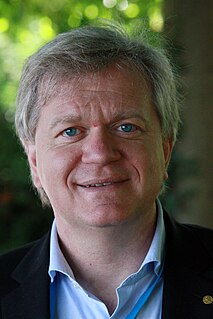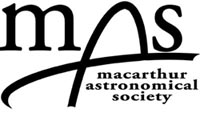Related Research Articles

Astronomy is a natural science that studies celestial objects and phenomena. It uses mathematics, physics, and chemistry in order to explain their origin and evolution. Objects of interest include planets, moons, stars, nebulae, galaxies, and comets. Relevant phenomena include supernova explosions, gamma ray bursts, quasars, blazars, pulsars, and cosmic microwave background radiation. More generally, astronomy studies everything that originates beyond Earth's atmosphere. Cosmology is a branch of astronomy that studies the universe as a whole.

The American Astronomical Society is an American society of professional astronomers and other interested individuals, headquartered in Washington, DC. The primary objective of the AAS is to promote the advancement of astronomy and closely related branches of science, while the secondary purpose includes enhancing astronomy education and providing a political voice for its members through lobbying and grassroots activities. Its current mission is to enhance and share humanity's scientific understanding of the universe.

The National Optical Astronomy Observatory (NOAO) is the United States national observatory for ground-based nighttime ultraviolet-optical-infrared (OUVIR) astronomy. The National Science Foundation (NSF) funds NOAO to provide forefront astronomical research facilities for US astronomers. However, professional astronomers from any country in the world may apply to use the telescopes operated by NOAO under the NSF's "open skies" policy. Astronomers submit proposals for peer review to gain access to the telescopes which are scheduled every night of the year for observations. The combination of truly open access and the merit based science proposal process makes NOAO unique in the world.
Jeremiah Paul "Jerry" Ostriker is an astrophysicist and a professor of astronomy at Columbia University and is the Charles A. Young Professor Emeritus at Princeton where he also continues as a Senior Research Scholar. Ostriker has also served as a university administrator as Provost of Princeton University.

The Square Kilometre Array (SKA) is an intergovernmental radio telescope project being planned to be built in Australia and South Africa. Conceived in the 1990s, and further developed and designed by the late-2010s, when completed it will have a total collecting area of approximately one square kilometre sometime in the 2020s. It will operate over a wide range of frequencies and its size will make it 50 times more sensitive than any other radio instrument. It will require very high performance central computing engines and long-haul links with a capacity greater than the global Internet traffic as of 2013. If built as planned, it should be able to survey the sky more than ten thousand times faster than before.

Mount Stromlo Observatory located just outside Canberra, Australia, is part of the Research School of Astronomy and Astrophysics at the Australian National University (ANU).

Bryan Malcolm Gaensler is an Australian astronomer based at the University of Toronto. He studies magnetars, supernova remnants, and magnetic fields. In 2014, he was appointed as Director of the Dunlap Institute for Astronomy & Astrophysics at the University of Toronto, after James R. Graham's departure. He is currently the co-chair of the Canadian 2020 Long Range Plan Committee with Pauline Barmby.

Robert P. Kirshner is an American astronomer, Chief Program Officer for Science for the Gordon and Betty Moore Foundation, and the Clowes Research Professor of Science at Harvard University. Kirshner has worked in several areas of astronomy including the physics of supernovae, supernova remnants, the large-scale structure of the cosmos, and the use of supernovae to measure the expansion of the universe.

Brian Paul Schmidt is the Vice-Chancellor of the Australian National University (ANU). He was previously a Distinguished Professor, Australian Research Council Laureate Fellow and astrophysicist at the University's Mount Stromlo Observatory and Research School of Astronomy and Astrophysics. He is known for his research in using supernovae as cosmological probes. He currently holds an Australia Research Council Federation Fellowship and was elected a Fellow of the Royal Society (FRS) in 2012. Schmidt shared both the 2006 Shaw Prize in Astronomy and the 2011 Nobel Prize in Physics with Saul Perlmutter and Adam Riess for providing evidence that the expansion of the universe is accelerating, making him the only Montana-born Nobel laureate.
Astroparticle physics, also called particle astrophysics, is a branch of particle physics that studies elementary particles of astronomical origin and their relation to astrophysics and cosmology. It is a relatively new field of research emerging at the intersection of particle physics, astronomy, astrophysics, detector physics, relativity, solid state physics, and cosmology. Partly motivated by the discovery of neutrino oscillation, the field has undergone rapid development, both theoretically and experimentally, since the early 2000s.

Geraint F. Lewis is a Welsh astrophysicist, who is best known for his work on dark energy, gravitational lensing and galactic cannibalism. Lewis is a Professor of Astrophysics at the Sydney Institute for Astronomy, part of the University of Sydney's School of Physics. He is head of the Gravitational Astrophysics Group. He was previously the Associate Head for Research at the School of Physics, and held an Australian Research Council Future Fellowship between 2011 and 2015. Lewis won the 2016 Walter Boas Medal in recognition of excellence in research in Physics.

Macarthur Astronomical Society is an organisation of amateur astronomers, based in the Macarthur Region of outer South Western Sydney, NSW, Australia, including the local government areas of the City of Campbelltown, Camden Council, Wollondilly Shire, the City of Liverpool and surrounding districts.

Macarthur Astronomy Forum is a monthly public forum organised by Macarthur Astronomical Society, providing leading national and international professional astronomers with a platform to address the Forum on topics of astronomical interest; also providing members of the Society and the general public with opportunities to learn and ask questions.

The International Centre for Radio Astronomy Research (ICRAR) is an international "centre of excellence" in astronomical science and technology based in Perth, Western Australia, launched in August 2009 as a joint venture between Curtin University and the University of Western Australia. The ICRAR attracts researchers in radio astronomy, contributing to Australian and international scientific and technical programs for the international Square Kilometre Array (SKA) project, the world's biggest ground-based telescope array which is in its design phase and the two Australian SKA precursors, the Australian Square Kilometre Array Pathfinder (ASKAP) and the Murchison Widefield Array (MWA), both located in Murchison. The headquarters of the ICRAR is located in Crawley.

Warrick John Couch is an Australian professional astronomer. He is currently a professor at Swinburne University of Technology in Melbourne. He was previously the Director of Australia's largest optical observatory, the Australian Astronomical Observatory (AAO). He was also the President of the Australian Institute of Physics (2015–2017), and a non-executive director on the Board of the Giant Magellan Telescope Organization. He was a founding non-executive director of Astronomy Australia Limited.
Elaine Margaret Sadler is an Australian astrophysicist. She is the Australia Telescope National Facility Chief Scientist and a Professor of Astrophysics in the School of Physics at the University of Sydney. She was elected as a fellow of the Australian Academy of Science (AAS) in 2010 and commenced a 4-year term as Foreign Secretary of the AAS in 2018. She was previously director of the CAASTRO centre (2014-2018).
Varun Bhisham Sahni is an Indian theoretical physicist, astrophysicist and a Distinguished Professor at the Inter-University Centre for Astronomy and Astrophysics. Known for his research on cosmology, Sahni is an elected fellow of all the three major Indian science academies viz. Indian Academy of Sciences, Indian National Science Academy and National Academy of Sciences, India. The Council of Scientific and Industrial Research, the apex agency of the Government of India for scientific research, awarded him the Shanti Swarup Bhatnagar Prize for Science and Technology, one of the highest Indian science awards, for his contributions to physical sciences in 2000.

Jamie S. Farnes is a British cosmologist, astrophysicist, and radio astronomer based at the University of Oxford. He studies dark energy, dark matter, cosmic magnetic fields, and the large-scale structure of the universe. In 2018, it was announced by Oxford that Farnes may have simultaneously solved both the dark energy and dark matter problems, using a new negative mass dark fluid toy model that "brings balance to the universe".
Prof. Tara Murphy is an Australian Astrophysicist and CAASTRO chief investigator working in the School of Physics at the University of Sydney. Murphy led a group that first confirmed radio emissions from the 2017 Neutron Star Merger event which provided evidence for a global scientific announcement in the field of gravitational waves.
References
- ↑ "CAASTRO: a new way of looking at the sky". sydney.edu.au. The University of Sydney News. 9 September 2011.
- ↑ Creagh, Sunanda. "New all-sky astrophysics research centre to tackle the big questions".
- ↑ "CAASTRO - About CAASTRO". www.caastro.org. Archived from the original on 3 September 2012. Retrieved 3 October 2012.
- ↑ "Management Team". www.caastro.org. CAASTRO. Archived from the original on 22 August 2017. Retrieved 7 February 2016.
- ↑ "Professor Elaine Sadler announced as new CAASTRO Director". www.caastro.org. CAASTRO. Archived from the original on 7 February 2016. Retrieved 7 February 2016.